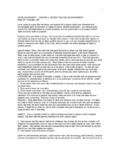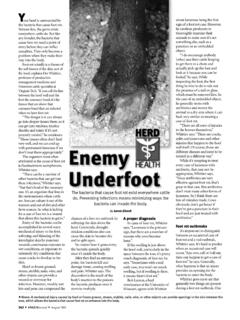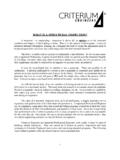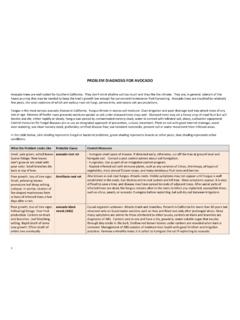Transcription of Installing Wood Posts for Greatest Longevity in …
1 FORFS 03-05 Introduction Kentucky farmers and stables install many thousands of dollars worth of wood fencing each year. Most fence Posts are treated with a wood preservative to increase their service life, but the installation method can affect the actual life of the fence post . These pages will serve as a quick guide to Installing preservative-treated fence Posts for the Greatest serviceable life. Buying Fence Posts Fence Posts are available from many retail outlets (such as Southern States), and either square or round debarked Posts can be purchased in different sizes. Horse farms in Central Kentucky, for example, frequently use 5 round debarked pine Posts . Most of the Posts available in Kentucky will probably be southern yellow pine, but Posts of other species (red pine, for example, from a different part of the country) might be sold by the same retail supplier.
2 Preservative-treated fence Posts will be tagged as having sufficient chemical retention for ground-contact exposure (for example, pounds per cubic foot for the preservative chemical CCA). Untreated Posts or Posts that have only received a dip-treatment are unsuitable for long-term use; they will first rot at the ground line where there is the best combination of water and air for fungi to grow1, and they will also be susceptible to termite attack. If properly treated and installed, pine fence Posts can last for 20 35 years; untreated pine Posts might only last 3 7 years. 1 How quickly they will rot depends on the amount of chemical in the Posts . Installing Fence Posts When large numbers of fence Posts need to be installed it is probably most practical to pound them into the ground with a hydraulic post driver, small end first.
3 post drivers are generally constructed so that little brooming of the driven end will occur, but installers generally prefer to drive Posts when the soil is slightly moist for obvious reasons. If the Posts are driven such that they remain a little tall or if they are not driven to identical heights, the ends will likely be cut off. It is common practice to slant the cut on the top end so that Posts will shed water, and Posts are usually painted according to the owner s preferences (Figure 1). Both of these practices are well-intentioned, but there are two things that MUST be done properly or the fence installation may suffer from rotting Posts in spite of the wood preservative treatment. Figure 1. Paddock Posts with tops cut at an Wood Posts for Greatest Longevity in Farm or Paddock Fencing Terry Conners, Extension Specialist for Forest Products, Department of Forestry How wood fence Posts are preserved: First, some background information: For the following discussion it is helpful to know how fence Posts are treated with preservative chemicals.
4 The Posts , five- and six-inch rounds, are generally either the leftover material from a plywood manufacturer ( peeler cores ) or small-diameter tree tops that are too small for lumber manufacture. When the fence Posts arrive at the wood treater s, they are still green (wet) and they must first be dried to remove some of the water; the Posts will subsequently be pressure-impregnated with either an oil- or a water-based chemical treatment, and you can t put fluid into a piece of wood that s already saturated with water. (CCA-treatment (the preservative chemical that turns wood green) involves impregnating wood with a water-based solution, for example.) After the preservative is forced into the wood under pressure, a vacuum is applied to remove excess chemical. Each batch of Posts is inspected to ensure that most (if not all) of the sapwood (the outer part of the tree) is chemically treated; the inner part of the tree, the heartwood, is impermeable in pines (and some other species) and will not accept the treatment chemical except for a little at the post ends (Figure 2).
5 2 (Although it can still decay, pine heartwood is slightly more resistant to decay than the sapwood. For this reason, and because it is surrounded by an envelope of protected sapwood, the presence of untreated heartwood in the center of the post is not generally considered to be a problem and the heartwood exposed at the post ends is immersed in the preservative chemical during treatment, so it also has some protection.) The now-treated Posts are still wet, but they are not dried a second time before they are shipped to the distribution facility. The Posts are now preserved against fungal or termite attack, and there is no need to remove the water before shipping them to the distributor. 2 Southern pine Posts have a thick sapwood layer and very little (if any) heartwood, but red pine Posts have a thin sapwood and significant amounts of heartwood.
6 Figure 2. Cross-section of log showing heartwood (H) and sapwood (S). post installation: Fence Posts are purchased from a retail outlet and a fencing contractor is hired to perform the installation in many cases because he has the equipment to do the job more quickly. The contractor will either drill holes for the Posts with an auger or the Posts will be pounded in with a hydraulic post driver. The next step in many fence installations is to trim the end of the post ; depending on the installation the Posts may or may not be trimmed for height above the ground, but many installers remove a wedge of wood from the top end to help water to run off the top of the post . This makes sense for an untreated post (wood has to be damp for decay to begin), but by removing some of the treated wood from the end an installer will likely expose some untreated wood. It would be best if the post installer does one of two things: 1.
7 Drive the Posts to a uniform depth and avoid cutting the post ends to height; 2. If it is necessary to trim the top of the post (either for height, or if it is desired to slant the top for appearance), then the cut end must be re-treated with a wood preservative to ensure that no exposed wood is susceptible to decay. An appropriate chemical to use would be Copper Napthenate ( , Cuprinol Wood (T. Conners 03/03) Educational programs of the Kentucky Cooperative Extension Service serve all people regardless of race, color, age, sex, religion, disability, or national origin. Preservative #10 Green, sold by Sherwin Williams3), and this should be liberally applied to cut surfaces with a brush or a sprayer. Posts that are pounded into hard soil may develop small cracks on the top surfaces of Posts . If these are observed, it would be a sensible precaution to treat the tops of these Posts with a wood preservative even if the tops are not cut, as these cracks could provide highways for fungal spores into the untreated post interior.
8 Allow Posts to air-dry Posts before painting them: On many horse farms the fence Posts and rails are painted after installation. Paint will add a little bit of a protective envelope to the Posts , but the underlying wood will shrink and develop cracks as it dries so the paint is useful for cosmetic purposes only. The fencing should be allowed to dry in the air for a few months after installation before it is painted. The water in the Posts would be trapped beneath a layer of paint, inhibiting its evaporation. As fungi need both food and water to grow, you not only eliminate potential paint adhesion problems by air-drying Posts before paint is applied but you also minimize any rotting that might be possible if untreated wood ( , food) and water were available simultaneously. Posts could begin to show early signs of failure beginning at the untreated tops.
9 Examples of problem installations: If fence Posts are painted while they are still wet a potentially expensive-to-correct situation could develop, especially if untreated wood is exposed ( , by trimming the upper end during installation). Figures 3 and 4 show two examples of Posts with differing degrees of degrade problems. Both of these CCA-treated pine Posts were photographed after being in place for only a few years. The Posts had the ends cut off, no 3 The use of a brand name constitutes neither a recommendation nor an endorsement of this product. remedial wood preservative treatments were applied, and they were both painted soon after installation. Figure 3. Treated pine post . The sapwood was properly preserved, but the untreated heartwood began to rot underneath the paint.
10 Brush-on remedial preservative treatment would probably have helped this particular post . Figure 4. Treated pine post . Untreated wood began to rot, with the sapwood being more significantly affected than the slightly more rot-resistant heartwood. This degree of sapwood degrade would not be expected for properly preserved wood, so this particular post may have had an inadequate preservative treatment. Its poor condition was probably worsened by the lack of after-cutting preservative treatment and by the paint applied soon after installation that trapped water within the post .



















